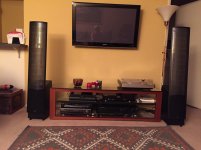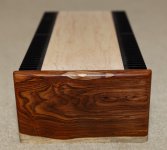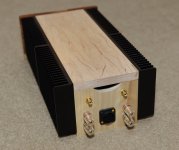How low can the quiescent current be set in the F6 without comprising sound quality? I am thinking of building an F6 with BA-3 front end as an integrated amp in a 4U Jack of all Chassis enclosure. However, I am constrained with where the amplifier will be located: on a shelf in a multi-level coffee table type piece of furniture. The table is very open, but the only place I can put the amp would be on a shelf that has only 8.25 inches (approx. 210 mm) between its floor and the bottom of the next shelf. I understand that it is recommended to have much more space above the amplifier to help the heatsinks perform according to spec.
I was thinking I might be able to run the amp a little cooler by reducing the Iq. (I do not need much power, I estimate that with my 91 db 4 ohm speakers I rarely if ever get above about 8 watts.) I see that the 6L6 build guide indicates 1.05 amps per device (for about 25 watts per device of heat). Can I get any heat benefit by reducing the quiescent current or will that compromise the amplifier?
I am intrigued by the F6 and would love to build it, but maybe I should look for an AB amp (maybe the ESP 3A) instead? (I am trying to keep this build simple and am a bit intimidated by the Honey Badger.)
Thanks for any thoughts,
Jazzzman
I was thinking I might be able to run the amp a little cooler by reducing the Iq. (I do not need much power, I estimate that with my 91 db 4 ohm speakers I rarely if ever get above about 8 watts.) I see that the 6L6 build guide indicates 1.05 amps per device (for about 25 watts per device of heat). Can I get any heat benefit by reducing the quiescent current or will that compromise the amplifier?
I am intrigued by the F6 and would love to build it, but maybe I should look for an AB amp (maybe the ESP 3A) instead? (I am trying to keep this build simple and am a bit intimidated by the Honey Badger.)
Thanks for any thoughts,
Jazzzman
Yes,
Simply the lower the bias, the lower the temp it runs at.
Try setting the bias to say 500mv or even lower and see how it sounds.
Simply the lower the bias, the lower the temp it runs at.
Try setting the bias to say 500mv or even lower and see how it sounds.
Pass DIY Addict
Joined 2000
Paid Member
Yep, bias has a pretty linear relationship with heat generation, so bringing down the bias definitely reduces the heat output.
The situation that you are describing, however, is not ideal for any Class A amp. The 4U chassis is about 7" tall (does this include feet?) and your opening is only 8.25" tall. I don't recommend this at all. This is even more problematic if the amp is going into a "cubby hole" with no cross ventilation for air, you are going to create a problem for yourself very quickly. If you are committed to this approach, cutting a significant hole and adding a quiet fan is definitely in order, though may still not be enough airflow. If the amp is going in a "tunnel" where both the front and back are open, this is a "somewhat" better situation, but you still need to think about something to force some air circulation.
The situation that you are describing, however, is not ideal for any Class A amp. The 4U chassis is about 7" tall (does this include feet?) and your opening is only 8.25" tall. I don't recommend this at all. This is even more problematic if the amp is going into a "cubby hole" with no cross ventilation for air, you are going to create a problem for yourself very quickly. If you are committed to this approach, cutting a significant hole and adding a quiet fan is definitely in order, though may still not be enough airflow. If the amp is going in a "tunnel" where both the front and back are open, this is a "somewhat" better situation, but you still need to think about something to force some air circulation.
Find a suitable Location for the thing ? As the real life answer.
It's the price of performance 😉
Not only do the Heastsinks warm up but so do the innards,
which also output a fair amount of Heat themselves ..That was unexpected.
I have 2.5" x 9" high x 12" wide heatsinks and temps have reached to 45 C
(IR gun gizmo readings/ warm by touch) during summer.
No substitute for 'too much' cooling
It's the price of performance 😉
Not only do the Heastsinks warm up but so do the innards,
which also output a fair amount of Heat themselves ..That was unexpected.
I have 2.5" x 9" high x 12" wide heatsinks and temps have reached to 45 C
(IR gun gizmo readings/ warm by touch) during summer.
No substitute for 'too much' cooling
Thank you all for the responses. I think I will have to face reality (that is always a problem with the laws of physics, they demand obedience!) and drop my plans for a class A amp for the moment. It is a shame though, I really liked the idea of the F6 (and the possibility of using the same chassis for future Pass projects).
Jazzzman
Jazzzman
Fairly Easily deterred then?
God gave us wires 🙂 so it's possible to remotely locate Bits of Audio gear.
God gave us wires 🙂 so it's possible to remotely locate Bits of Audio gear.
Pass DIY Addict
Joined 2000
Paid Member
Or just downsize: think about an ACA instead of an F6... It is small enough to rest on top of a speaker.
Thanks for the encouragement. I will definitely try something, it just looks like the F6 is not in the picture at present. The determining element is the WAF, which prevents me from just putting it on top of the table alongside my turntable. I suspect a class AB amp in a 3U chassis would be one solution.
Would the ACA be able to handle 4 ohm speakers? I almost think I could get away with 5 watts (or would that be 10 watts into 4 ohms?). My speakers are Martin Logan ESL (the hybrid ones with a cone driver below 500 hz and the electrostatic membrane above 500 hz). (They don't offer much surface area to place amps, unless I could use the top of the box with the woofer (but that would place the amp directly behind the membrane). The impedance of those speakers swings quite a bit, I am not sure if that would pose a problem. I have attached a graph that illustrates impedance (yellow line) and phase (red line) versus frequency to show you what I mean.
Thanks for your input.
Would the ACA be able to handle 4 ohm speakers? I almost think I could get away with 5 watts (or would that be 10 watts into 4 ohms?). My speakers are Martin Logan ESL (the hybrid ones with a cone driver below 500 hz and the electrostatic membrane above 500 hz). (They don't offer much surface area to place amps, unless I could use the top of the box with the woofer (but that would place the amp directly behind the membrane). The impedance of those speakers swings quite a bit, I am not sure if that would pose a problem. I have attached a graph that illustrates impedance (yellow line) and phase (red line) versus frequency to show you what I mean.
Thanks for your input.
Attachments
Pass DIY Addict
Joined 2000
Paid Member
I'm thinking the ACA might not be happy with Martin Logans, but this is only a guess on my part. Some pictures of your setup might help. There are always solutions: amps on floor, hidden behind something, in adjacent room with wires through the wall, smaller chassis, etc
This is DIY so just use some other method of cooling the F6 rather than big heatsinks that require the ventilation e.g.
http://www.diyaudio.com/forums/pass-labs/299312-liquid-cooled-f6.html
http://www.diyaudio.com/forums/pass-labs/299312-liquid-cooled-f6.html
Pass DIY Addict
Joined 2000
Paid Member
Things don't look as bad as you think they are! You have TONs of flexibility and room there! With a little bit more effort than purchasing a ready-made chassis, you can have a VERY nice looking F6 to add to your stack of audio gear. The "jack of all trades" box functions very well, but is a bit "industrial looking" and doesn't fit neatly into every room.
I made a "modular" F4 (same power dissipation as the F6) amp with an outboard power supply that fits in a surprisingly small space. If I remember when I get home, I'll upload an image of my F4 so you can see. I made it with four U3 heatsinks from the DIYAudio store and the overall size is 7.5" wide x 3.5" tall x 18" deep. The side panels are just the heatsinks themselves and the top and front plates are wood (natural cherry and cocobolo). Thus, you could build one to match the woodwork for your table and it would blend in beautifully. Alternatively you could put it on top of the bass chamber for your speakers, or on the floor behind or next to your table. Your table looks like it curves in at the back allowing a little bit more room on the floor.
Your nice Martin Logans deserve a nice Pass amp to drive them. Don't give up so easily!
I made a "modular" F4 (same power dissipation as the F6) amp with an outboard power supply that fits in a surprisingly small space. If I remember when I get home, I'll upload an image of my F4 so you can see. I made it with four U3 heatsinks from the DIYAudio store and the overall size is 7.5" wide x 3.5" tall x 18" deep. The side panels are just the heatsinks themselves and the top and front plates are wood (natural cherry and cocobolo). Thus, you could build one to match the woodwork for your table and it would blend in beautifully. Alternatively you could put it on top of the bass chamber for your speakers, or on the floor behind or next to your table. Your table looks like it curves in at the back allowing a little bit more room on the floor.
Your nice Martin Logans deserve a nice Pass amp to drive them. Don't give up so easily!
Thank you, Eric. I would be very interested in seeing your F4. I guess I just have to think more outside the box!
Pass DIY Addict
Joined 2000
Paid Member
Something went wrong with my last post, so here it is again...
This is my F4 amp. Sorry, but the dimensions I provided in my previous message were incorrect. The amp actually measures 5" tall 9" wide and 17" deep. This is the amp only, note the Neutric connector on the back for the DC power supply input. The front and rear wooden panels are a bit taller than the heatsink so they lift the sinks off the table top by about 1/2". The hole in the back panel allows a bit of air circulation through the amp. One of these days, I'll get around to creating a chassis for the power supply, too. This size of a chassis should be able to work with any of the First Watt variety of amps as they all burn in the neighborhood of 180-200 watts.
This is my F4 amp. Sorry, but the dimensions I provided in my previous message were incorrect. The amp actually measures 5" tall 9" wide and 17" deep. This is the amp only, note the Neutric connector on the back for the DC power supply input. The front and rear wooden panels are a bit taller than the heatsink so they lift the sinks off the table top by about 1/2". The hole in the back panel allows a bit of air circulation through the amp. One of these days, I'll get around to creating a chassis for the power supply, too. This size of a chassis should be able to work with any of the First Watt variety of amps as they all burn in the neighborhood of 180-200 watts.
Attachments
Your amplifier looks really nice! Thank you for the pictures. Your idea for the module approach appeals to me. I should be able to squeeze the modules in somewhere. You have given me hope for the F6!
I will do a bit more research on building a chassis and wiring a remote power supply. I just have to plan this project out one step at a time.
Thanks again.
Jazzzman
I will do a bit more research on building a chassis and wiring a remote power supply. I just have to plan this project out one step at a time.
Thanks again.
Jazzzman
Pass DIY Addict
Joined 2000
Paid Member
This is the fun part of DIY - you are in control and don't have to accept the design choices of others! There are lots of great examples around.
besides , if you put some energy in your WAF judgment system .......... you'll have much more choices ...... 

- Status
- Not open for further replies.
- Home
- Amplifiers
- Pass Labs
- Quiescent current in F6



